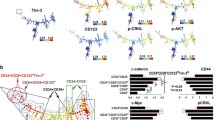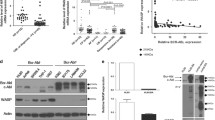Abstract
Chronic myeloid leukemia (CML) results from malignant transformation of hematopoietic stem cells induced by the BCR-ABL oncogene. Transformation from chronic to blastic phase is the lethal step in CML. Leukemic stem cells (LSCs) are the basic reason for blastic transformation. It has been shown that Wnt/β-catenin signaling contributes to the self-renewal capacity and proliferation of LSCs in CML. However, the role of Wnt/β-catenin signaling in blastic transformation of CML is still obscure. Here, we explored the relationship between BCR-ABL and β-catenin signaling in vitro and in vivo. We found that BCR-ABL stimulated β-catenin via activation of PI3K/AKT signaling in blastic phase CML cells. Inhibition of the kinase activity of BCR-ABL, PI3K, or AKT decreased the level of β-catenin in both K562 cells and a CML mouse model and suppressed the transcription of downstream target genes (c-myc and cyclin D1). In addition, inhibition of the BCR-ABL/PI3K/AKT pathway delayed the disease progression in the CML mouse model. To further explore the role of β-catenin in the self-renewal and survival of CML LSCs, we established a secondary transplantation CML mouse model. Our data revealed that inhibition of the BCR-ABL/PI3K/AKT pathway reduced the tumor-initiating ability of K562 cells, decreased leukemia cell infiltration into peripheral blood and bone marrow, and prolonged the survival of mice. In conclusion, our data indicate a close relationship between β-catenin and BCR-ABL/PI3K/AKT in blastic phase CML. β-Catenin inhibition may be of therapeutic value by targeting LSCs in combination with a tyrosine kinase inhibitor, which may delay blastic transformation of CML.








Similar content being viewed by others
References
Becker MW, Jordan CT. Leukemia stem cells in 2010: current understanding and future directions. Blood Rev. 2011;25(2):75–81.
Rice KN, Jamieson CH. Molecular pathways to CML stem cells. Int J Hematol. 2010;91(5):748–52.
Gerber JM, Qin L, Kowalski J, et al. Characterization of chronic myeloid leukemia stem cells. Am J Hemato. 2011;86(1):31–7.
Quintás-Cardama A, Cortes J. Molecular biology of bcr-abl1-positive chronic myeloid leukemia. Blood. 2009;113:1619–30.
Melo JV, Barnes DJ. Chronic myeloid leukaemia as a model of disease evolution in human cancer. Nat Rev Cancer. 2007;7(6):441–53.
Perrotti D, Jamieson C, Goldman J, et al. Chronic myeloid leukemia: mechanisms of blastic transformation [J]. J Clin Invest. 2010;120(7):2254.
Sawyers CL. Chronic myeloid leukemia. N Engl J Med. 1999;341(10):765.
Druker BJ, Sawyers CL, Kantarjian H, et al. Activity of a specific inhibitor of the BCR-ABL tyrosine kinase in the blast crisis of chronic myeloid leukemia and acute lymphoblastic leukemia with the Philadelphia chromosome. N Engl J Med. 2001;344(14):1038–42.
Graham SM, Jørgensen HG, Allan E, et al. Primitive, quiescent, Philadelphia-positive stem cells from patients with chronic myeloid leukemia are insensitive to STI571 in vitro. Blood. 2002;99(1):319–25.
Hu Y, Swerdlow S, Duffy TM, et al. Targeting multiple kinase pathways in leukemic progenitors and stem cells is essential for improved treatment of Ph+ leukemia in mice. Proc Natl Acad Sci U S A. 2006;103(45):16870–5.
Eiring AM, Khorashad JS, Morley K, et al. Advances in the treatment of chronic myeloid leukemia. BMC Med. 2011;9:99.
Kantarjian H, Sawyers C, Hochhaus A, et al. Hematologic and cytogenetic responses to imatinib mesylate in chronic myelogenous leukemia. International STI571 CML Study Group. N Engl J Med. 2002;346(9):645–52.
Kinstrie R, Copland M. Targeting chronic myeloid leukemia stem cells. Curr Hematol Malig Rep. 2013;8(1):14–21.
Malhotra S, Kincade PW. Wnt-related molecules and signaling pathway equilibrium in hematopoiesis. Cell Stem Cell. 2009;4:27–33.
Abrahamsson AE, Geron I, Gotlib J, et al. Aberrant regulation of Wnt/beta-catenin pathway mediators in chronic myelogenous leukemia stem cells. Blood (ASH Ann Meet Abstr). 2006;108:2135.
Zhao C, Blum J, Chen A, et al. Loss of beta-catenin impairs the renewal of normal and CML stem cell in vivo. Cancer Cell. 2007;12(4):528–41.
Staal FJ, Clevers HC. Wnt signaling and hematopoiesis: a WNT-WNT situation. Nat Rev Immunol. 2005;5(1):21–30.
Huntly BJ, Gilliland DG. Leukaemia stem cells and the evolution of cancer-stem-cell research. Nat Rev Cancer. 2005;5(4):311–21.
de Sousa EM, Vermeulen L, Richel D, et al. Targeting Wnt signaling in colon cancer stem cells. Clin Cancer Res. 2011;17(4):647–53.
Dodge ME, Lum L. Drugging the cancer stem cell compartment: lessons learned from the hedgehog and Wnt signal transduction pathways. Annu Rev Pharmacol Toxicol. 2011;51:289–310.
Jamieson CH, Ailles LE, Dylla SJ, et al. Granulocyte–macrophage progenitors as candidate leukemic stem cells in blast-crisis CML. N Engl J Med. 2004;351(7):657–67.
Gunsilius E. Evidence from a leukemia model for maintenance of vascular endothelium by bone marrow-derived endothelial cells. Adv Exp Med Biol. 2003;522:17–24.
Coluccia AM, Vacca A, Duñach M, et al. Bcr-Abl stabilizes β-catenin in chronic myeloid leukemia through its tyrosine phosphorylation. EMBO J. 2007;26:1456–66.
He XC, Yin T, Grindley JC, et al. PTEN-deficient intestinal stem cells initiate intestinal polyposis. Nat Genet. 2007;39(2):189–98.
Guo W, Lasky 3rd JL, Wu H. Cancer stem cells. Pediatr Res. 2006;59(4 Pt 2):59R–64R.
Pool CR. Hematoxylin-eosin staining of OsO4-fixed epon-embedded tissue; prestaining oxidation by acidified H2O2. Stain Technol. 1969;44(2):75–9.
McCubrey JA, Steelman LS, Bertrand FE, et al. Multifaceted roles of GSK-3 and Wnt/beta-catenin in hematopoiesis and leukemogenesis: opportunities for therapeutic intervention. Leukemia. 2014;28(1):15–33.
AS Corbin A, Agarwal M. Loriaux, et al. human chronic myeloid leukemia stem cells are insensitive to imatinib despite inhibition of BCR-ABL activity. J Clin Invest. 2011;121(1):396–409.
Calabretta B, Perrotti D. The biology of CML blast crisis. Blood. 2004;103(11):4010–22.
Nelson WJ, Nusse R. Convergence of Wnt, beta-catenin, and cadherin pathways. Science. 2004;303(5663):1483–7.
Kolligs FT, Bommer G, Göke B. Wnt/beta-catenin/tcf signaling: a critical pathway in gastrointestinal tumorigenesis. Digestion. 2002;66(3):131–44.
Regmi SC, Park SY, Kim SJ, et al. The anti-tumor activity of succinyl macrolactin A is mediated through the β-catenin destruction complex via the suppression of tankyrase and PI3K/Akt. PLoS One. 2015;10(11):e0141753.
Meng F, Li H, Shi H, et al. MACC1 down-regulation inhibits proliferation and tumourigenicity of nasopharyngeal carcinoma cells through Akt/β-catenin signaling pathway. PLoS One. 2013;8(4):e60821.
Cross DA, Alessi DR, Cohen P, et al. Inhibition of glycogen synthase kinase-3 by insulin mediated by protein kinase B. Nature. 1995;378(6559):785–9.
Ishibe S, Haydu JE, Togawa A, et al. Cell confluence regulates hepatocyte growth factor-stimulated cell morphogenesis in a beta-catenin-dependent manner. Mol Cell Biol. 2006;26(24):9232–43.
Voskas D, Ling LS, Woodgett JR. Does GSK-3 provide a shortcut for PI3K activation of Wnt signalling? F1000 Biol Rep. 2010;2:82.
Li C, Zhou C, Wang S, et al. Sensitization of glioma cells to tamoxifen-induced apoptosis by Pl3-kinase inhibitor through the GSK-3β/β-catenin signaling pathway. PLoS One. 2011;6(10):e27053.
Liu C, Li Y, Semenov M, et al. Control of β-catenin phosphorylation/degradation by a dual-kinase mechanism. Cell. 2002;108(6):837–47.
Wang PS, Chou FS, Bloomston M, et al. Thiazolidinediones downregulate Wnt/β-catenin signaling via multiple mechanisms in breast cancer cells. J Surg Res. 2009;153(2):210–6.
Shirasaki R, Tashiro H, Oka Y, et al. Chronic myelogenous leukemia cells contribute to the stromal myofibroblasts in leukemic NOD/SCID mouse in vivo. J Oncol. 2012;2012:901783.
Li L, Wang L, Li L, et al. Activation of p53 by SIRT1 inhibition enhances elimination of CML leukemia stem cells in combination with imatinib. Cancer Cell. 2012;21(2):266–81.
Acknowledgments
This work was funded by the Natural Science Foundation of CQ CSTC (cstc2012jjA10013) to Jing Hu and the Special Fund of Chongqing Key Laboratory (CSTC) (2012-2015) to Jing Hu.
Author information
Authors and Affiliations
Corresponding author
Ethics declarations
This study was authorized by the Human Ethics Committee of Chongqing Medical University. All participants provided written informed consent.
The ethical standards includes:
1. Whether the project should be carried out with experimental animal experiment. Whether it could be done with computer simulation, cell culture or lower animals instead of higher animal.
2. Whether the animals used in this experiment are suitable. Whether the number of animals could be reduced through improved design or high quality animals.
3. Whether animals are treated ethically through improving experiment method, adjusting experimental observation index, optimizing the experiment scheme.
4. Whether animal welfare measures are implemented.
Ethical approval
All procedures performed in studies involving animals were in accordance with the ethical standards of the institution or practice at which the studies were conducted.
Conflicts of interest
None
Rights and permissions
About this article
Cite this article
Hu, J., Feng, M., Liu, ZL. et al. Potential role of Wnt/β-catenin signaling in blastic transformation of chronic myeloid leukemia: cross talk between β-catenin and BCR-ABL. Tumor Biol. 37, 15859–15872 (2016). https://doi.org/10.1007/s13277-016-5413-3
Received:
Accepted:
Published:
Issue Date:
DOI: https://doi.org/10.1007/s13277-016-5413-3




